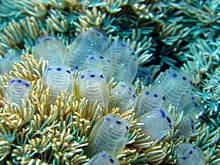Species of tunicate From Wikipedia, the free encyclopedia
Clavelina moluccensis, common name bluebell tunicate, blue bell tunicate, or blue sea squirt [2] is a species of tunicate (sea squirt), in the genus Clavelina (the "little bottles"). Like all ascidians, these sessile animals are filter feeders.
| Clavelina moluccensis | |
|---|---|
 | |
| A colony of Clavelina molluccensis, showing the characteristic row of three blue dots between the siphons | |
| Scientific classification | |
| Domain: | Eukaryota |
| Kingdom: | Animalia |
| Phylum: | Chordata |
| Subphylum: | Tunicata |
| Class: | Ascidiacea |
| Order: | Aplousobranchia |
| Family: | Clavelinidae |
| Genus: | Clavelina |
| Species: | C. moluccensis |
| Binomial name | |
| Clavelina moluccensis (Sluiter, 1904)[1] | |
| Synonyms | |
|
Clavelina molluccensis (Sluiter, 1904) (misspelling in literature) | |
This species is 0.5-2.5 cm long, and light to medium blue in colour. The top of the zooids contain characteristic dark blue patches and spots that are always visible.[3]
This species is found in the waters around Australia,[4] Western Pacific, Indonesia, Papua New Guinea, Mariana Islands,[2] Philippines, Singapore, and Malaysia.[2]
This species grows in clusters attached to dead coral[5] or other hard substrates, normally under overhangs.[2]
Seamless Wikipedia browsing. On steroids.